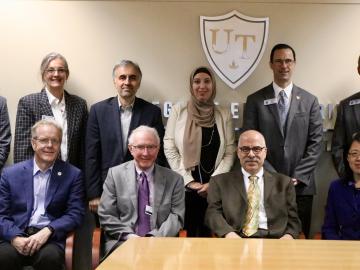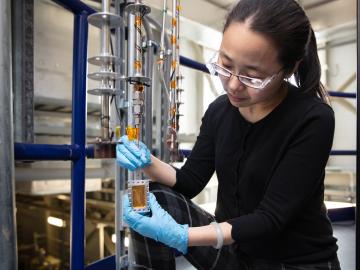
Filter News
Area of Research
- (-) Materials (52)
- (-) Supercomputing (62)
- Advanced Manufacturing (7)
- Biological Systems (2)
- Biology and Environment (126)
- Biology and Soft Matter (1)
- Building Technologies (2)
- Computational Engineering (1)
- Computer Science (4)
- Electricity and Smart Grid (1)
- Energy Science (139)
- Energy Sciences (1)
- Functional Materials for Energy (1)
- Fusion and Fission (7)
- Fusion Energy (1)
- Isotopes (25)
- Materials for Computing (7)
- Mathematics (1)
- National Security (29)
- Neutron Science (15)
- Nuclear Science and Technology (8)
- Quantum information Science (3)
News Topics
- (-) Bioenergy (18)
- (-) Composites (9)
- (-) Cybersecurity (8)
- (-) Environment (35)
- (-) Frontier (32)
- (-) Isotopes (14)
- 3-D Printing/Advanced Manufacturing (26)
- Advanced Reactors (5)
- Artificial Intelligence (39)
- Big Data (22)
- Biology (14)
- Biomedical (22)
- Biotechnology (2)
- Buildings (8)
- Chemical Sciences (32)
- Clean Water (3)
- Computer Science (99)
- Coronavirus (17)
- Critical Materials (15)
- Energy Storage (37)
- Exascale Computing (26)
- Fusion (8)
- Grid (9)
- High-Performance Computing (45)
- Irradiation (1)
- ITER (1)
- Machine Learning (15)
- Materials (79)
- Materials Science (83)
- Mathematics (2)
- Microscopy (29)
- Molten Salt (3)
- Nanotechnology (42)
- National Security (8)
- Neutron Science (42)
- Nuclear Energy (20)
- Partnerships (11)
- Physics (34)
- Polymers (18)
- Quantum Computing (21)
- Quantum Science (33)
- Security (7)
- Simulation (16)
- Software (1)
- Space Exploration (5)
- Summit (43)
- Transportation (19)
Media Contacts

Gina Tourassi has been appointed as director of the National Center for Computational Sciences, a division of the Computing and Computational Sciences Directorate at Oak Ridge National Laboratory.

Students often participate in internships and receive formal training in their chosen career fields during college, but some pursue professional development opportunities even earlier.

Researchers at the Department of Energy’s Oak Ridge National Laboratory have received five 2019 R&D 100 Awards, increasing the lab’s total to 221 since the award’s inception in 1963.

ORNL and The University of Toledo have entered into a memorandum of understanding for collaborative research.

Quanex Building Products has signed a non-exclusive agreement to license a method to produce insulating material from ORNL. The low-cost material can be used as an additive to increase thermal insulation performance and improve energy efficiency when applied to a variety of building products.

A modern, healthy transportation system is vital to the nation’s economic security and the American standard of living. The U.S. Department of Energy’s Oak Ridge National Laboratory (ORNL) is engaged in a broad portfolio of scientific research for improved mobility

A new method developed at Oak Ridge National Laboratory improves the energy efficiency of a desalination process known as solar-thermal evaporation.
A team of scientists led by Oak Ridge National Laboratory have discovered the specific gene that controls an important symbiotic relationship between plants and soil fungi, and successfully facilitated the symbiosis in a plant that

Researchers at the Department of Energy’s Oak Ridge National Laboratory, Pacific Northwest National Laboratory and Washington State University teamed up to investigate the complex dynamics of low-water liquids that challenge nuclear waste processing at federal cleanup sites.

OAK RIDGE, Tenn., May 7, 2019—The U.S. Department of Energy today announced a contract with Cray Inc. to build the Frontier supercomputer at Oak Ridge National Laboratory, which is anticipated to debut in 2021 as the world’s most powerful computer with a performance of greater than 1.5 exaflops.


